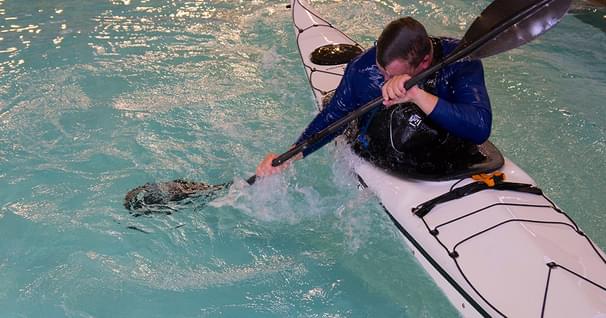Basic Kayak Strokes
Think You've Got It? Take the Quiz and Prove It!
TAHE 10'6 & 11'6 SUP-YAK Inflatables
2-in-1 Kayak & Paddle Board complete packages for single or tandem use.
Basic Strokes
When on the water, you need to do three basic things in your boat:
- Go forward in a straight line
- Stop or go backwards
- Turn
There's a stroke for all three.
The forward stroke is the most basic and the one you'll use most of the time. Grip your paddle loosely with your hands about shoulder width apart and if your paddle has scooped blades, hold it so the scoop side is facing you. Now reach one paddle blade toward your feet and place it in the water, twist your body to get that reach and then twist back to pull the blade to your hips. That way you used your core muscles and not just your arms.
Don't pull too far, anything past the hips is wasted motion. So take the blade out when it reaches your hips and repeat the stroke on the opposite side of the kayak. That's it, you’re paddling.
When you want to stop or slow down place a paddle blade in the water and push gently forward, away from your body, slowing the kayak. If you're going fast, you might need to alternate sides to keep the boat on a straight line as it slows down.
Backing up is the same as the forward stroke but in reverse. Place your blade at your hips and push away from the body.
When stopping or backpedaling don't spin your blades around, it's not worth the effort or confusion. Just keep the same paddle grip as before. Hand shoulder width apart, relaxed grip, and the scoop part of the blade facing you.
Pro-tip: asymmetrical paddle blades are designed to have the longest part of the blade on top. If the scoop side is facing backward and the longest part of the blade is not on top, flip it around like a helicopter.
As you paddle forward, especially at first, the boat may veer off course and you'll need to use some correction strokes. If the front of your kayak veers off to the right a bit you can use a sweep stroke on the same side to correct it. This stroke modifies the forward stroke by reaching out away from the side of your kayak, making a wide C motion with your paddle blade. This creates much more turning motion than a normal forward stroke and used just the right time, it will get you right back on course.
It may take some trial and error but you’ll figure it out as you go. Going straight will become second nature, but it's just not at first, so paddle around in circles for a bit, practicing these strokes, and eventually, you'll get it.
Those are the basic strokes to get you started. But if you want to jump start your learning process and take your paddling to the next level it's a great idea to take a class. Classes are also a great way to meet other paddlers and learn about fun places to paddle. Check your local paddling shop or go online to find instructors in your area.
And remember: "Be smart, Be safe, and Have fun."
paddling.com has partnered with the United States Coast Guard to bring you this 8-part "Safer Paddling Series" featuring ACA-certified instructors Kate Ross Kuthe and Paul Kuthe. Watch them all as Paul and Kate share valuable safety tips, paddling technique pointers, and other various gear tips.
Related Articles
When a night-fishing mission goes awry, two kayak anglers learn the importance of staying calm and…
By changing how you edge and balance your boat you can increase your stability and adaptability. Using…
Mention “pool session” and the first image that pops into most kayakers minds is a class in how to roll.…
Photo Credit: Darlene Patterson Many people who have paddled for years can't keep a canoe on a straight…





